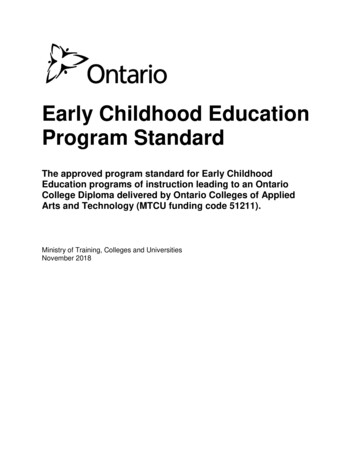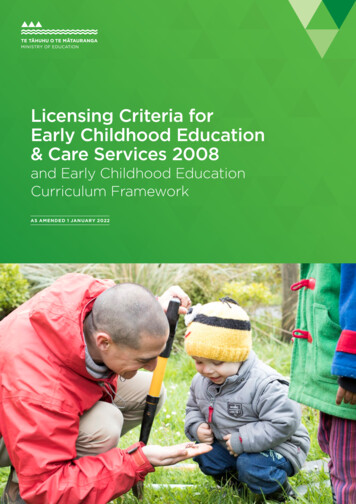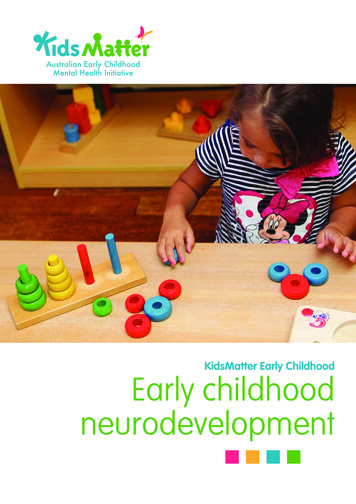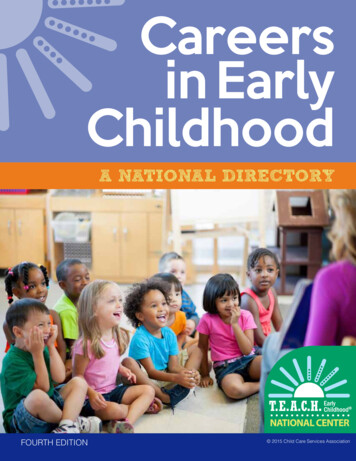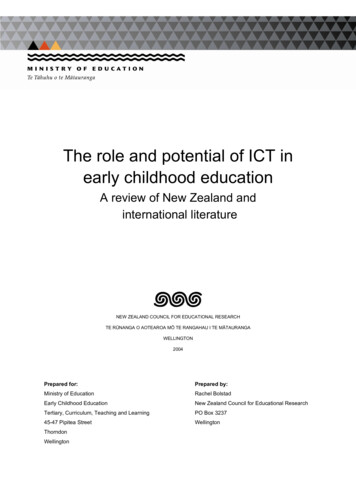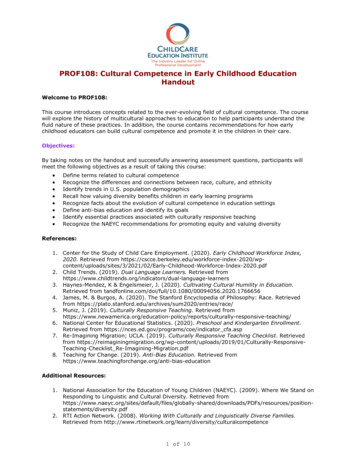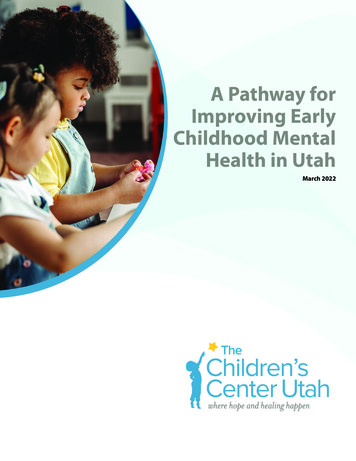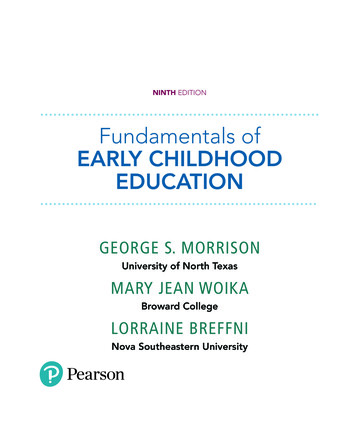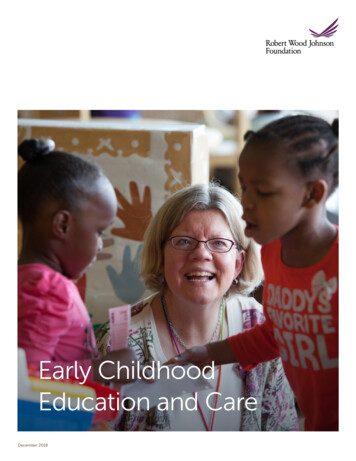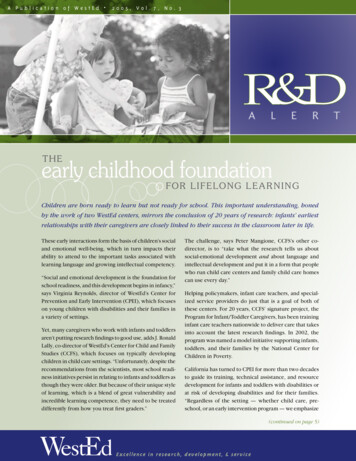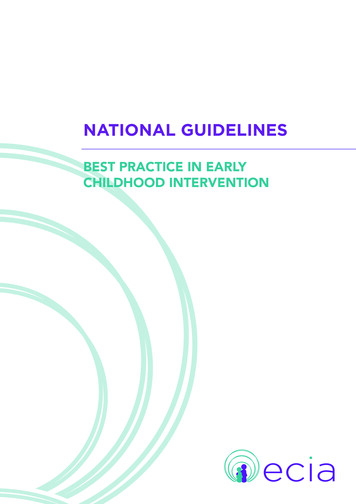
Transcription
NATIONAL GUIDELINESBEST PRACTICE IN EARLYCHILDHOOD INTERVENTION
DisclaimerThe information set out in this publication is current at the date of first publication and is intended for useas a guide of a general nature only and may or may not be relevant to particular clients or circumstances.Nor is this publication exhaustive of the subject matter. Persons implementing any recommendationscontained in this publication must exercise their own independent skill or judgement or seek appropriateprofessional advice relevant to their own particular circumstances when so doing.AcknowledgementsThe National Guidelines for Best Practice in Early Childhood Intervention (1st edition) are guidelinesdeveloped by the Sector for the Sector.Early Childhood Intervention Australia acknowledges the generous financial assistance provided by theNDIS Sector Development Fund, which enabled the development of the National Guidelines for BestPractice in Early Childhood Intervention.Early Childhood Intervention Australia convened a national Steering Committee to assist with thedevelopment of national guidelines. The Steering Committee brought together a collection of individualswith expert knowledge and skills within the field of Early Childhood Intervention to complement the skillsand knowledge of the Project Team.Project TeamEarly Childhood Intervention Australia (Victorian Chapter) - Project LeadDavid Quin – ECIA VC (Chair)Dree Ballardin – Secretariat and Project LeadSue Davies – Senior Project OfficerSteering CommitteeLynne Adamson – NDIA RepresentativeDenise Luscombe – National President ECIA and ECI RepresentativeProfessor Anita Bundy – Academic RepresentativeAnoo Bhopti – Academic Representative and ECI RepresentativeEarly Childhood Intervention would also like to acknowledge the input and feedback provided by theExpert Advisory Group (EAG). This group consisted of 60 ECI professionals and practitioners in a varietyof roles who provided invaluable input to the Project team. For the full list of EAG members, go idelines-project/expert-advisory-group.National Guidelines for Best Practice in Early Childhood Intervention1
Our Vision: for young children of all abilities tofully participate in family and community life.
CONTENTS1: BACKGROUND42: KEY BEST PRACTICES IN ECI73: RATIONALE FOR KEY BEST PRACTICES IN ECI8Quality Area 1: Family8Family-centred and Strengths-based PracticeCulturally Responsive PracticeQuality Area 2: Inclusion11Inclusive and Participatory PracticeEngaging the Child in Natural EnvironmentsQuality Area 3: Teamwork13Collaborative Teamwork PracticeCapacity-building PracticeQuality Area 4: Universal Principles16Evidence base, Standards, Accountability and PracticeOutcome-based Approach4: CONCLUSION205: REFERENCES21National Guidelines for Best Practice in Early Childhood Intervention3
1 : BACKGROUNDWhat is Early Childhood Intervention?Early Childhood Intervention (ECI) is the process of providing specialised support and services for infants andyoung children with disability and/or developmental delay, and their families, in order to promote development,well-being and community participation www.ecia.org.auTim Moore, leading expert in ECI, states that the overall aim of ECI is to ensure that the parents or other keycaregivers are able to provide young children who have disability and/or developmental delay with experiencesand opportunities that promote the children’s acquisition and use of competencies which enable the children toparticipate meaningfully in the key environments in their lives (2012).ECI practitioners work in partnership with parents/caregivers, families and other significant stakeholders toenhance their knowledge, skills and supports to meet the needs of the child, optimise the child’s learning anddevelopment, and the child’s ability to participate in family and community life (Bruder, 2010; Dunst, 2007).Why are the early years Important?The early childhood years lay the foundation for all future development. Recent scientific evidence shows thatearly experiences shape our lives by affecting the way the young brain develops. What happens to us in the earlyyears has a major effect on our health and social development through to adulthood. Therefore, we must ensurethat children’s early experiences are positive - that they have a secure foundation for development. (Sameroff,2009; Shonkoff, 2010; Shonkoff & Phillips, 2000; Sroufe, 2009; Worthman et al., 2010).The early childhood years are just as important for children with disability and/or developmental delay as they arefor all children. All their future development is based on the critical learning patterns laid down during this period.The early years are also critical for the whole family. This is when families can best begin to learn how to supportand nurture their child, how to meet their child’s needs, and how to adapt positively to having a child with disabilityand/or developmental delay.The Early Intervention Seven Key Principles: Looks Like/Doesn’t Look LikeThe Early Intervention Seven Key Principles: Looks Like/ Doesn’t Look Like presents in plain language bestpractice principles and their application for infants and toddlers in ECI settings. The seven universal principlesidentified are:15Infants and toddlers learn best through every day experiencesand interactions with familiar people in familiar contexts.Individual Family Service Plan outcomes must be functionaland based on children’s and families’ needs and priorities26All families, with the necessary supports and resources, canenhance their children’s learning and development.The family’s priorities, needs and interests are addressedmost appropriately by a primary provider who represents andreceives team and community support.3The primary role of the service provider in early intervention isto work with and support the family members and caregiversin a child’s life.4The early intervention process, from initial contacts through totransition, must be dynamic and individualised to reflect thechild’s and family members’ preferences, learning styles andcultural beliefs.47Interventions with young children and family membersmust be based on explicit principles, validated practices,best available research and relevant laws and regulations.(WPPNE, 2008)This document is endorsed by the NDIA and can be accessedon the NDIA website.National Guidelines for Best Practice in Early Childhood Intervention
Early Childhood Intervention Australia (ECIA)Early Childhood Intervention Australia is the peak body for early childhood intervention in Australia, representingprofessionals and organisations that provide services for young children with disability and/or developmental delayand their families.Early Childhood Intervention under the National Disability Insurance SchemeECI services in Australia will henceforth be delivered via the National Disability Insurance Scheme (NDIS) underthe auspices of the National Disability Insurance Agency (NDIA) the independent statutory agency whose role isto implement the NDIS or possibly the Disability Service Commission (WA only) depending on the outcome of anindependent evaluation.The NDIS is new to disability service provision in Australia and provides a set of agreements that ensures thatthere is a single consistent scheme for the provision of disability support services across all Australian statesand territories. It provides funding directly to individuals who are able to choose their own services and purchasedirectly from providers. The NDIS will essentially mean the end to ‘block funding’ from government to serviceproviders. It is expected that the scheme will be fully operational in most jurisdictions and the sector transitioncomplete by the year 2019-20.The NDIS enables participants to access reasonable and necessary supports, including early intervention, withmore choice and control over how, when and where supports are provided.ECIA considers early childhood intervention as supporting a child’s development of functional skills that wouldenable them to participate meaningfully in everyday activities alongside typically developing peers. Earlychildhood intervention supports need to be provided in a way which is inclusive of the family so that activities aretargeted to encourage the learning and development of the child and are reinforced and complemented in familysettings. In this sense, the goals of the family, their values and priorities need to be integral to the developing earlyintervention approach to ensure that ECI will make the most significant impact (ECIA, NSW Chapter, 2014).Rationale - National Guidelines for Best Practice in Early Childhood InterventionCurrent practices in ECI in Australia vary across and within states and territories. As a national scheme, the NDISrequires national guidelines for best practice that may be consistently applied in all states and territories.The purpose of these guidelines and recommendations is to provide a framework for universal and equitablehigh quality ECI based on best practice for children with disability and/or developmental delay whether theyattend government, non-government, large, small, sole non-for-profit service providers or private providers,anywhere in Australia.Development Phase of the National Guidelines for Best PracticeThese guidelines and recommendations draw upon extensive consultation with the ECI sector and keystakeholders.In May and June 2015, ECIA undertook a series of consultation workshops across Australia. The starting point fordiscussions with the ECI sector on the best practices in ECI was the Early Intervention Best Practice DiscussionPaper developed by ECIA in 2014. This paper was distributed as pre-reading for the National Guidelinesconsultation workshops.The objectives of these workshops were to: review current practice in Early Childhood Intervention across Australia; identify key best practices in ECI that are agreed upon by the ECI sector and its stakeholders across Australia;National Guidelines for Best Practice in Early Childhood Intervention5
identify any environmental factors impacting upon current ECI practice; identify strategies to address gaps between current ECI practices and best practice in ECIOver 400 participants attended these workshops in eleven diverse locations across Australia. Locations includedGeelong, Melbourne, Sydney, Newcastle, Canberra, Brisbane, Rockhampton, Darwin, Perth, Adelaide andHobart. Eleven submissions from key organisations on the Guidelines on Best Practice were also received. Theworkshop reports make for a unique insight into the state of practice in early childhood intervention acrossthe country. Please go to the ECIA National website to view the Emerging Themes Reports for each of theseworkshops.The feedback provided to ECIA during the consultation phase of the National Guidelines project was then crossreferenced against Australian and international research and literature in Early Childhood Intervention.The final consultation was engagement with the Expert Advisory Group (EAG) which consists of 60 experts in adiversity of fields related to ECI. They were asked to critically review the final draft document.For a full list of the EAG members go to: rojectFrom the review of current literature and extensive consultation with the ECI sector, four quality areas wereidentified comprising of eight key recommended best practices in ECI which are found on the following page. Therationale for each of these best practices can be found in Section 3: Rationale for Key Best Practices in ECI (p.8).6National Guidelines for Best Practice in Early Childhood Intervention
2 : KEY BEST PRACTICES IN EARLY CHILDHOOD INTERVENTIONFrom a review of current international and Australian literature and extensive consultation withthe ECI sector, four quality areas were identified comprising of eight key best practices in EarlyChildhood Intervention (ECI).Quality Area 1: Family1. Family-Centred and Strengths-Based Practice: is a set of values, skills, behaviours and knowledge thatrecognises the central role of families in children’s lives. Family-centred practice is a way of thinking and actingthat ensures that professionals and families work in partnership and that family life, and family priorities andchoices, drive what happens in planning and intervention. Family-centred practice builds on family strengthsand assists families to develop their own networks of resources – both informal and formal.2. Culturally Responsive Practice: creates welcoming and culturally inclusive environments where all familiesare encouraged to participate in and contribute to children’s learning and development. Practitioners areknowledgeable and respectful of diversity and provide services and supports in flexible ways that areresponsive to each family’s cultural, ethnic, racial, language and socioeconomic characteristics.Quality Area 2: Inclusion3. Inclusive and Participatory Practice: recognises that every child regardless of their needs has the right toparticipate fully in their family and community life and to have the same choices, opportunities and experiencesas other children. All children need to feel accepted and to have a real sense of belonging. Children withdisability and/or developmental delay may require additional support to enable them to participate meaningfullyin their families, community and early childhood settings.4. Engaging the Child in Natural Environments: promotes children’s inclusion through participation in dailyroutines, at home, in the community, and in early childhood settings. These natural learning environmentscontain many opportunities for all children to engage, participate, learn and practise skills, thus strengtheningtheir sense of belonging.Quality Area 3: Teamwork5. Collaborative Teamwork Practice: is where the family and professionals work together as a collaborative andintegrated team around the child, communicating and sharing information, knowledge and skills, with one teammember nominated as a key worker and main person working with the family.6. Capacity-Building Practice: encompasses building the capacity of the child, family, professionals andcommunity through coaching and collaborative team work. The goal is to build the knowledge, skills andabilities of the individuals who will spend the most time with the child in order to have as great an impact aspossible on the child’s learning and development.Quality Area 4: Universal Principles7. Evidence Base, Standards, Accountability and Practice: ECI services comprise practitioners withappropriate expertise and qualifications who use intervention strategies that are grounded in research andsound clinical reasoning. Standards based on these ECI key best practices will ensure ECI practitioners andservices are accountable to continuous improvement and high quality services.8. Outcome Based Approach: focuses on outcomes that parents want for their child and family, and onidentifying the skills needed to achieve these outcomes. ECI practitioners share their professional expertiseand knowledge to enable families to make informed decisions. Outcomes focus on participation in meaningfulactivities in the home and community with outcomes measured and evaluated by ECI services from a child,family and community perspective.National Guidelines for Best Practice in Early Childhood Intervention7
3 : RATIONALE FOR KEY BEST PRACTICESIN EARLY CHILDHOOD INTERVENTIONFrom a review of current international and Australian literature and extensive consultation withthe ECI sector, four quality areas were identified comprising of eight key best practices in EarlyChildhood Intervention (ECI). The rationale for each of these best practices is detailed below.Quality Area 1: Family1. Family-Centred and Strengths-Based Practice: is a set of values, skills, behaviours and knowledge thatrecognises the central role of families in children’s lives. Family-centred practice is a way of thinking and actingthat ensures that professionals and families work in partnership and that family life, and family priorities andchoices, drive what happens in planning and intervention. Family-centred practice builds on family strengthsand assists families to develop their own networks of resources – both informal and formal.Within Australian and international ECI literature, family-centred and strengths-based practice areconsidered best practices (Dew et al. 2014; Fordham et al. 2012). There was broad consensus across theECI National Guidelines consultation workshops on these practices and that family-centred practice, inparticular, is the foundation for best practice in Early Childhood Intervention.Family-Centred PracticeFamily centred practice is made up of a set of values, attitudes and approaches for working in partnership withchildren and their families. Family centred practice is not just a specialist way of working with a child with disabilityand/or developmental delay, and their families, but is now established best practice for anyone working withchildren and families. In fact, it has rapidly emerged as the preferred model for working with people of all ages andcircumstances.There is now strong evidence for the approach, including that it improves child behaviour and wellbeing,family functioning, levels of social support available to families and family satisfaction with services, and that itcontributes to these primarily by increasing parental self-efficacy (Dempsey & Dunst, 2004; Dempsey & Keen,2008; Gavidia-Payne et al., 2015; Guralnick, 2011). Importantly, family-centred practice, is indirectly linked toimproved developmental outcomes for the child, through building the self-efficacy of the family (Dunst & Trivette,2009). The approach is also supported in school settings by evidence of the benefits of family–school partnershipsfor all students (DHS & DEECD, 2012).Family centred practice recognises that: Each family is unique and different. The family is the constant in the child’s life. The family is the expert on the child’s abilities and needs. Optimal child functioning occurs within a supportive family and community context; the child is affected by thestress and coping of other family members.Guiding principles of family centred practice: Each family should have the opportunity to decide the level of involvement they wish in the decision makingfor their child. Parents have ultimate responsibility for their child. Each family and family member should be treated with respect. The strengths and needs of all family members should be supported and encouraged.(Law et al., 2003; CCCH, 2004. DHS & DEECD, 2012).8National Guidelines for Best Practice in Early Childhood Intervention
As children learn in the context of their families, families are the primary influence on children’s learning anddevelopment (Bruder, 2010; DEECD, 2011). A key role of ECI is to support parents/caregivers and educatorsto enable them to provide children with experiences and opportunities that promote using and developing theirskills (Moore, 2012). Families, educators and community partners who feel respected and supported by ECIpractitioners and who feel competent in the skills needed to interact with the child are better able to promote achild’s social, cognitive and behavioural developments (Gavidia-Payne et al., 2015).A model developed by Dunst, Trivette and Deal (1988) on enabling and empowering families has influenced thethinking about family centred practice for decades. The model has since been expanded to a Helpgiving Practicesmodel (Dunst 2010; Dunst & Trivette, 2009; Dunst et al., 2007) which identifies three key components of effectivecapacity-building family-centred helpgiving: Relational practices build relationships and are about the help giver’s beliefs, values and attitudes, and theirinterpersonal behaviours and skills. Participatory practices are where the help giver empowers families to make informed decisions and takeaction, and ensures that the help giver responds to each family’s unique and changing needs. Technical quality is about the help giver having the information, knowledge and expertise needed to deliverhigh-quality supports and services, and applying it for the benefit of children and families.Research and clinical practice have increasingly indicated that how help is provided is as important as what isprovided if help giving is to have positive consequences (Dunst & Trivette, 2009; Dunst et al., 2007). The abilityof ECI professionals to support families depends not only on their technical knowledge and skills in working withchildren with disability and/or developmental delay, but also upon their personal qualities and skills in buildingpositive working relationships with parents and supporting family’s choice and participation (Moore, 2012).Providing family-centred services can be a challenge to some practitioners. Family-centred practice does requirea shift in power and authority away from the professional as ‘expert’ and key decision-maker and towards thefamily. In fact, additional expertise is required to empower families (DHS & DEECD, 2012).Partnering with families and communities to support a child to learn, grow and thrive is an integral part of familycentred practice. ECI professionals share their professional expertise and knowledge with the family and atthe same time regard the family’s expertise as valid, significant and valuable. They position themselves asknowledgeable consultants who support families’ choices and values. Providing families and their social supportswith information can, in itself, enable families and other key stakeholders to make choices and decisions (Bailey &Powell, 2005; Fordham et al., 2012).Strengths-based practiceAll families, with the necessary supports and resources, can enhance their children’s learning and development(WPPNE, 2008).Strengths-based practice builds on family members’ competencies; supports families to make decisions forthemselves; and focuses on empowering families to do things for themselves within their social communities.Rather than focusing on correcting peoples’ weaknesses or problems, capacity-building and strength-basedstrategies recognise the assets and talents of people and help people use these competencies to strengthenfunctioning (Caspe & Lopez, 2006; Dunst & Trivette, 2009; Dunst, 2007).For the child, strengths-based practice means that ECI practitioners focus on what each child can do, or showsemerging ability to do in different contexts, and on the opportunities these afford, rather than what the child is notable to do and potential barriers to development (ECIA, NSW Chapter, 2014).Effective ECI services build on the existing strengths of children, families and the communities in which theyinteract. Focusing on existing strengths promotes an individual’s sense of control and is integral to facilitatingempowerment (Dempsey & Dunst, 2004). ECI services that adopt a strengths-based practice are more effectiveand empowering to families and community stakeholders leading to better long-term outcomes (Green et al.,2004). For the ECI practitioner, it also requires an awareness and understanding that all families are resourcefulbut do not always have the ability or knowledge to access the resources and supports they require.National Guidelines for Best Practice in Early Childhood Intervention9
Increasingly, ECI practitioners are faced with families with complex and multiple needs. All families, includingfamilies of children with disability and/or developmental delay, face a range of factors that can compromiseparental, personal and family functioning. These include factors such as housing, finances, transport, socialsupport, parental/caregiver physical and mental health, drug and alcohol issues and family violence (Moore,2012). The presence of one or more of these factors can undermine parents’ and caregivers’ abilities to addresstheir children’s needs, and is particularly so for families with complex cultural backgrounds such as Aboriginal andTorres Strait Islander and migrant families (Guralnick, 2011).It is imperative that these risk factors and needs are addressed in a holistic manner in order to affect anymeaningful and sustainable change, improve family functioning and ensure the child has the required supports. Ifthese factors are not addressed, they will undermine the family’s capacity to put supports around their child andjeopardise achievement of positive outcomes.The essential task for ECI practitioners in delivering family-centred and strengths-based programs is to identifythe strategies and experiences that will suit the needs and circumstances of a particular family, and to work withthe family to build these strategies into their everyday life (Dunst & Trivette, 2009; KPMG, 2014; Guralnick, 2011;CCCH, 2011; Moore, 2012). The ECI practitioner must have a good knowledge of the community system so thatthey can link families into appropriate universal services and then to provide assistance to support these servicesto accommodate the needs of the family and child if necessary. An important point for practitioners to remember isthat families do have the right to make choices for themselves and their child unless they contravene the law.2. Culturally Responsive Practice: creates welcoming and culturally inclusive environments where allfamilies are encouraged to participate in and contribute to children’s learning and development. Practitionersare knowledgeable and respectful of diversity and provide services and supports in flexible ways that areresponsive to each family’s cultural, ethnic, racial, language and socioeconomic characteristics.In all of the consultation workshops, culturally responsive practices or cultural competencies werehighlighted as an important best practice. It was acknowledged that ECI practitioners need to be moreculturally responsive and culturally competent to work effectively with the diversity of families acrossAustralia. Respecting diversity of families was noted as a key feature central to family-centred practice.Culturally responsive practice and family-centred practice are deeply linked because culture profoundly shapesboth human development and family structures, whatever a family’s culture. Children’s personal, family andcultural histories shape their learning and development (DEECD, 2011). A family’s culture may also affectattitudes, values, beliefs and capacities across a number of areas including: child-rearing practices; healthpractices; meanings of disability; perceptions of education; and perceptions of ECI (Madden, 2005).Family-centred practice requires services to take into account each family’s socio-cultural and socio-economicrelated expectations for development and participation (Dew et al., 2014). Families are less likely to participateor stay engaged with ECI services when their cultural background is ignored (CCCH, 2011).Culturally responsive practice is when professionals and organisations respond respectfully and skilfully to theneeds of diverse communities. It can be seen as part of a broader concept of cultural competence, describedas a set of ‘congruent behaviours, attitudes and policies that come together in a system or agency or amongprofessionals’ that enable effective work in cross-cultural situations (National Medical and Health ResearchCouncil in DHS & DEECD, 2012). A lack of adequate cultural competencies, including personal maturity andthoughtfulness in outlook and practice, ability to achieve functional therapeutic outcomes with interpreters,ability to work with community leaders/educators and use translated resources effectively is a significant barrierto working with culturally and linguistically diverse families and Aboriginal and Torres Strait Islander families(Dew et al., 2014; Lindsay et al., 2012).Translation and interpretation services for families where English is not their first language is an importantpart of being culturally competent. Where possible an appropriately skilled interpreter should be offered toavoid difficulties that might arise from having family members or friends interpret. However, family preferencesmust be considered and there may be occasions where it is most appropriate for a family member or friend tointerpret. Other needs and priorities of the family should be respected in the selection of the interpreter - factorssuch as the interpreter’s gender and religion may also be important (Madden, 2005).10National Guidelines for Best Practice in Early Childhood Intervention
Recognising the complexities contributing to a family’s diversity, respecting the family’s personal and socialresources and being able to cater to diversity are key features of family-centred practice (Dew et al., 2014).Understanding the practices, values, beliefs and cultures of families, and the immediate and extendedcommunities in which they interact are fundamental to the best practice of ECI.Quality Area 2: Inclusion3. Inclusive and Participatory Practice: recognises that every child regardless of their needs has the right toparticipate fully in their family and community life and to have the same choices, opportunities and experiencesas other children. All children need to feel accepted and to have a real sense of belonging. Children withdisability and/or developmental delay may require additional support to enable them to participate meaningfullyin their families, community and early childhood settings.There was broad consensus across all ECI National Guidelines consultation workshops on the importanceof inclusion. The Early Childhood Intervention Australia (ECIA) and Early Childhood Australia (ECA) 2012statement, ‘Position on the Inclusion of Children with Disability in Early Childhood Education and Care’,has contributed to raising people’s awareness of the
Practice in Early Childhood Intervention. Early Childhood Intervention Australia convened a national Steering Committee to assist with the development of national guidelines. The Steering Committee brought together a collection of individuals with expert knowledge and skills within the field of Early Childhood Intervention to complement the skills
